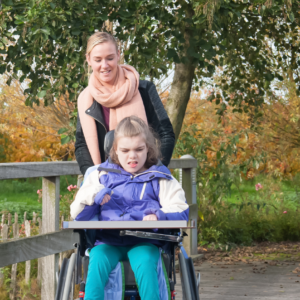Adaptations to your home
If your home is a difficult place for your child to live in, your local council has a responsibility to look at how to make it safer and more accessible. These kinds of changes are called ‘adaptations’ and they can be made to a home you own, a home you are renting from the council or a private landlord.
What is an adaptation?
An adaptation is a change or changes to a property that mean a disabled person can move more freely and independently around their own home. Adaptations can range from simple things like installing a handrail or bath seat to widening doors, installing stair lifts or even creating entire wheelchair friendly bathrooms or kitchens. If your child needs specialist equipment like a hoist, this may also be considered at the same time as the other changes.
How to get an adaptation
Adaptations are usually managed by social care occupational therapists. You can contact them directly or, if you already have a social worker, you can ask them to refer you to the social care OT team directly.
- In Brighton & Hove, assessments for adaptations are managed by social care occupational therapists in the Children’s Disability Team. Call 01273 295 550 or email: [email protected]
- In East Sussex, assessments for adaptations are carried out by a multi-disciplinary team including occupational therapists and physiotherapists working as part of the Children’s Integrated Therapy and Equipment Service (CITES). Contact Therapy One Point on 0300 123 2650.
The occupational therapist (OT) will visit you at home to discuss what you need and assess to see if you are eligible for support. They will look at your disabled child’s current and likely future needs as well as the needs of the whole family. If the OT agrees that an adaptation is necessary, they will make recommendations to your local council.
The OT will supervise any work you are having done. Be aware that only works recommended by the therapist will be paid for and these have to be considered essential and not just desirable.
A word about waiting times
Getting a major home adaptation can take a long time so don’t wait until your situation is desperate before you ask for help. The process can be time consuming and frustrating, so the sooner you ask the better.
Paying for home adaptations
Adaptations can be funded in various ways:
- the council funds adaptations to council homes
- adaptations to an owner-occupied, privately rented or housing association home that cost less than £1,000 will usually be provided free of charge by the council
- for adaptations that cost more than £1,000 you will need to apply for a Disabled Facilities Grant (DFG).
- charities may help with funding for some adaptations or equipment

Disabled Facilities Grant (DFG)
The maximum amount for the Disabled Facilities Grant is £30,000. For adults, this grant is means tested but this is not the case if the work is for a disabled child under 19.
If the work you require amounts to more than £30,000, you may be asked to pay towards the costs and your income will be taken into account for this extra amount. Sometimes, the local authority may decide to assist with the extra costs but how much they pay will depend on your income plus the work must be considered essential and not just desirable.
There is an expectation that you will remain in your adapted property for a number of years. If you move within 10 years of the works being completed, government guidance says that councils can consider asking you to repay some or all of the DFG. However, they also need to take into account whether this would cause hardship, whether you are relocating for work, whether the move will improve your wellbeing or enable you to carry on caring. We don’t know of any families who have been asked to repay their DFG, but each council will have their own position on this which you should read in their DFG policy.
Be aware that you do not need to pay VAT on certain adaptations to your home. This will make work cheaper. https://www.gov.uk/guidance/vat-relief-on-certain-building-work-if-you-have-a-disability
When costs are above £30,000, the council may also work with other council departments or agencies to look at re-housing.
When to apply
Be aware that you cannot apply for a Disabled Facilities Grant when work has already begun. You must apply beforehand.
Social services have six months to make a decision, but this only begins once a formal application for a DFG has been made. You do not need to have an OT assessment before applying; social services cannot refuse to allow you to apply for a DFG.
Read more about assessments for equipment and adaptations in Brighton & Hove.
Read more about assessments for equipment and adaptations in East Sussex.
Or visit Scope’s website for more advice on getting home adaptations. https://www.scope.org.uk/advice-and-support/home-adaptations/#Getting-home-adaptations-click
Practical tips for the adaptations process
Need more advice about the practicalities of building and planning an adaptation? Read our SENDIASS tips on managing home adaptations, produced together with parent carers who have been through the process already.




